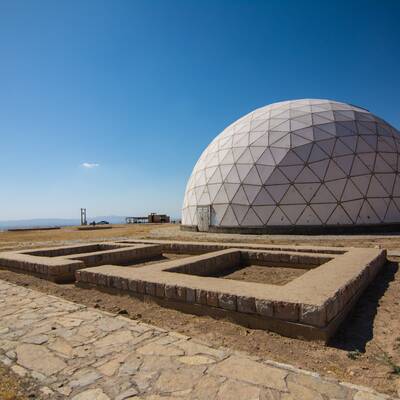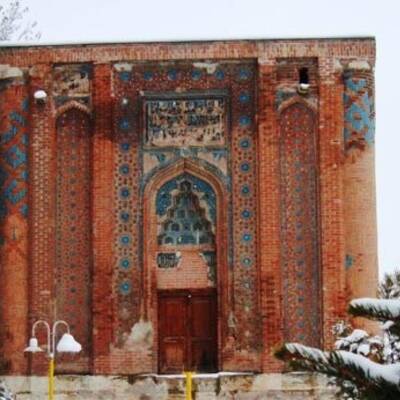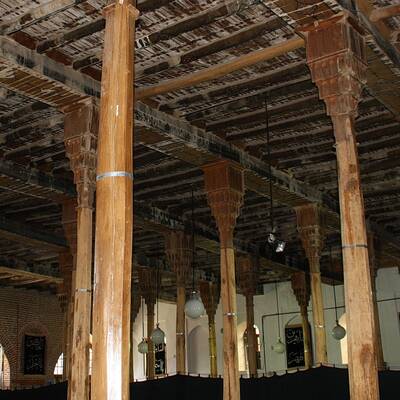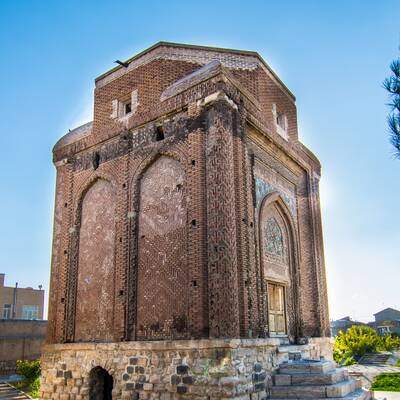
Kabootar (pigeon) Cave or Hampoeil Cave
As one of the old cities in East Azerbaijan Province with an observatory, which is still a gathering place for astronomers, Maragheh receives annually many travelers. There is also a river crossing the center of the city and also some historical monuments such as Gonbad-e-Sorkh, Ghaffariyeh Dome, and Jama Masjid (congregational mosque).
There is Mehr Temple that shows that Maragheh is an ancient city, but it was during Ilkhanids that the city faced the peak of its development, when Hulagu Khan the Mongol ruler, chose it as capital. Sahand Mountain, Sufi Chay river, and mineral springs are some touristic attractions in the city. There are also some natural attractions which are not well known, Kabootar Cave or Hampoeil Cave is one of them that its exploring needs some pieces of equipment and technical skills.
The cave situated in southeast Maragheh, the right side of the Mourdi Chay river. There are two ways to this cave: an asphalt pavement from Maragheh to Saraskand (Hashtrood) with ten kilometer length that continue to a fifteen-kilometer-long dirt road. It runs through the village of "Tazeh Kand-e Sofla". The second road is a twenty-kilometer-long, winding mountain road. The Cave entrance can be reached after passing many mineral springs on the coast of the Mourd Chay river.
Regarding archaeological pieces of evidence and the discovery of several stone tools, researchers estimate that the cave dates back to the Stone Age. Since only fifty percent of the cave was discovered by caverns, it can be a place for new natural and historical discoveries.
This cave called Kabbotar (pigeon) cave due to pigeon gathering in the entrance and inside the cave. Locales call it Hampoeil Cave. Hamdallah Mustawfi writes about this cave in Nuzhat Al Qulub: “there is a well in Janbadagh village in Maragheh where there are lots of pigeons, the traps are on the well and the pigeons are caught, The depth of that well is over five hundred Guz (a unit of length used in parts of Asia which ranged from 24 to 41 inches, 610 to 1,040 mm, over time)…”. The cave is one thousand and six hundred meters high; the entrance is five meters long and 10 meters wide and twenty-five to thirty-five meters high. There is a Russian-language inscription dated 1925 AD.
After entering the cave, there is a vast square without any decoration of stalactites. It has just two beautiful holes where bats and pigeons were supposed to live there. there live the bats at the end of the cave which are destroyed because of enormous tourist arrivals and disregard for the environment. On the right, a narrow path that is difficult to pass through connects this square to the second. There are four holes and a dangerous trough in the second square which ignorance would be life-threatening, as it happened some disasters for the tourists. These holes are the one who makes the cave more mysterious. There were two aquifers inside the holes in which one of them was destroyed by the collapse of the floors, and there is another aquifer in which sound is heard but not seen. it is not possible to go to the second square and to reach to the troughs without pieces of equipment such as oxygen tank, headlamp and spotlight, rope, and especially a guide because there is not enough oxygen near the third and the forth trough and also, it is possible to be lost. In addition to beautiful and attractive calcareous sediments and stalagmites that dazzle the eyes and double the beauty of the cave in the second square, this cave has some amazing halls that the cavers called each due to their actions, for example, Sad Hall, Temple Hall, Trough and Bat Well, Mirror Hall, ski resort, the well fo Davoud, etc. for example, the cavers believe when light is reflected by the ceiling as it is a mirror. What is so special about this cave is the fact that there is some dust in the first and the second square caused by Geological changes and they sometimes reach the knees.
There are some plans for investment and the infrastructure of tourism under construction. Cultural Heritage, Handicrafts and Tourism Organization of Iran considered some welfare facilities such as prayer rooms, Toilets, and asphalt pavement. But it is better that the tourists avoid the waste, destroy vegetation and damage calcareous sediments and gondolas so that these nature attractions rest as a souvenir for the next gener

.jpg)


